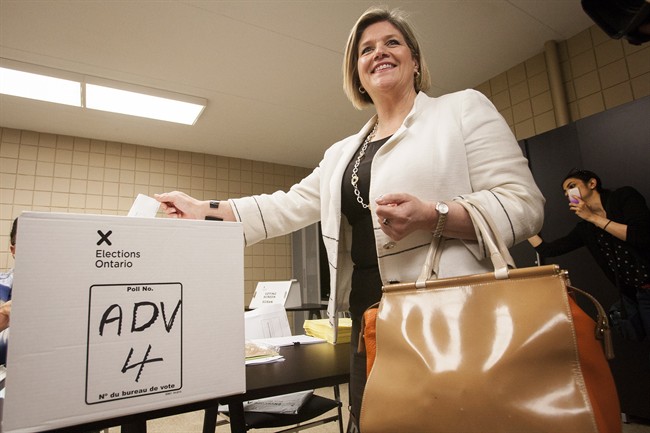TORONTO – Ontarians heading to the polls today have a record number of female candidates to choose from, including two women vying for the premier’s office, but the issues that dominated the campaign were not split along gender lines, observers say.

With the economy taking centre stage, none of the main party leaders – Liberal Premier Kathleen Wynne, the NDP’s Andrea Horwath and Tim Hudak of the Progressive Conservatives – made significant election pitches directed specifically at women, or men.
READ MORE: Ontarians head to the polls today
“It’s a little bit surprising that given it’s an unusual election – because two of the three party leaders are women and the incumbent premier is a woman – that there hasn’t been more of an overt difference on policy initiatives that concern women versus men,” said Cristine de Clercy, co-director of the Leadership and Democracy Lab at Western University.
“I suspect at least part of the reason … has to do with the fact that this campaign is fundamentally for many voters a question of how can we preserve Ontario’s economic well-being going forward without deteriorating its social infrastructure.”
That being said, de Clercy noted that no party can afford to ignore female voters, who are often concerned about areas like education and health care.
READ MORE: Ontario election: New poll shows three-way race
- Toronto’s offices are emptying out. The city wants to know what to do with them
- Capital gains changes could have ‘irreversible’ effects, business groups warn
- Could notwithstanding clause be used on abortion? Poilievre’s office says ‘never’
- U.K. takes aim at allies like Canada, wants higher NATO targets
“There’s good empirical evidence that female voters have slightly different policy priorities than male voters…No party can afford to take them for granted,” she said.
“I think some voters and all parties still think about politics in gender terms, I don’t think we’re past that point. But I do think in this campaign gender as a policy orientation has been a lot more muted.”
Nonetheless, the marked increase in the number of women running for office is something that voters concerned with gender parity – whether they’re male or female – will likely appreciate, said de Clercy.
“They often look at the proportion of women running as a proxy for a party’s openness to diversity,” she explained, adding that all Ontarians could be proud of the increase in female candidates in this campaign.
“This election marks the high point of female legislative participation and leadership participation. That is something to mark as noteworthy.”
BLOG: Ontario election: Does anyone really care?
Equal Voice, an organization which advocates for more women to be elected to all levels of government in Canada, found that there are 145 women running for office among the Liberals, Progressive Conservatives, NDP and the Greens.
That’s an improvement from the last provincial election when 130 women ran for the four parties in 2011.
“That’s a historic high in terms of women nominated,” said Equal Voice’s Donna Dasko, adding that women voters generally like to see their fellow females on their ballots.
“They’re somewhat more likely to say they’ll support a party if they’ll run a female candidate,” she said.
“In that sense it is a positive thing for women to have women running and it’s a positive thing for a party to have women running for the party. I think (political parties) are picking up on that.”
The New Democrats have the most women running with 44 female candidates, up from 38 in the last election. The Tories also nominated more women this time around with 27 candidates, up from 24 in the 2011 election. For the Liberals that number dropped from 42 female candidates to 37.
What the figures don’t show, however, is that only 40 women are running in ridings where they have a reasonable chance of winning, said Dasko, citing an analysis done by her organization.
“There are lots of barriers to this,” Dasko said. “When you have a lot of incumbents running there’s not a lot of room for change and it’s harder for women to get these nominations.”
Still, having two women in the running for the premier’s office is certainly a sign of progress, Dasko said.
“From a symbolic point of view it’s very important to have women leaders because we can see that women can take on these positions and can do so successfully,” she said.
“I think the political parties have come to understand that women can be winners and they can win for their parties and I think that’s a really important development.”



Comments